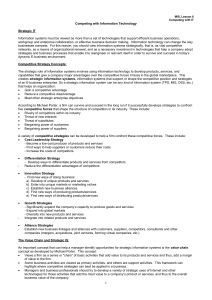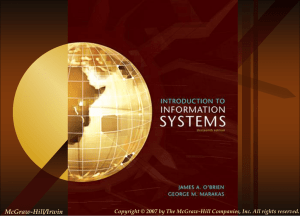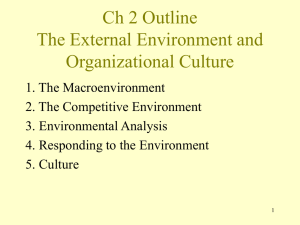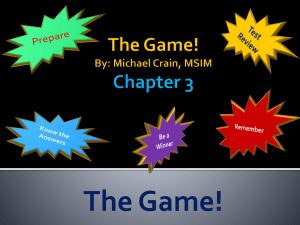innovation fundamentals
advertisement
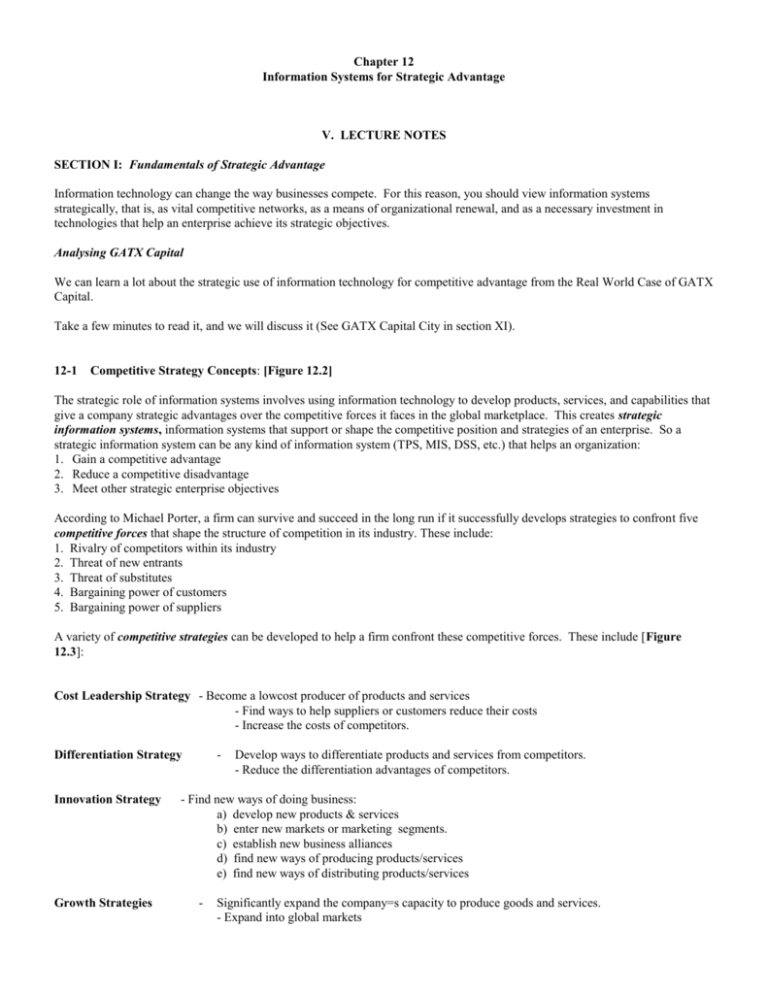
Chapter 12 Information Systems for Strategic Advantage V. LECTURE NOTES SECTION I: Fundamentals of Strategic Advantage Information technology can change the way businesses compete. For this reason, you should view information systems strategically, that is, as vital competitive networks, as a means of organizational renewal, and as a necessary investment in technologies that help an enterprise achieve its strategic objectives. Analysing GATX Capital We can learn a lot about the strategic use of information technology for competitive advantage from the Real World Case of GATX Capital. Take a few minutes to read it, and we will discuss it (See GATX Capital City in section XI). 12-1 Competitive Strategy Concepts: [Figure 12.2] The strategic role of information systems involves using information technology to develop products, services, and capabilities that give a company strategic advantages over the competitive forces it faces in the global marketplace. This creates strategic information systems, information systems that support or shape the competitive position and strategies of an enterprise. So a strategic information system can be any kind of information system (TPS, MIS, DSS, etc.) that helps an organization: 1. Gain a competitive advantage 2. Reduce a competitive disadvantage 3. Meet other strategic enterprise objectives According to Michael Porter, a firm can survive and succeed in the long run if it successfully develops strategies to confront five competitive forces that shape the structure of competition in its industry. These include: 1. Rivalry of competitors within its industry 2. Threat of new entrants 3. Threat of substitutes 4. Bargaining power of customers 5. Bargaining power of suppliers A variety of competitive strategies can be developed to help a firm confront these competitive forces. These include [Figure 12.3]: Cost Leadership Strategy - Become a lowcost producer of products and services - Find ways to help suppliers or customers reduce their costs - Increase the costs of competitors. Differentiation Strategy Innovation Strategy Growth Strategies - Develop ways to differentiate products and services from competitors. - Reduce the differentiation advantages of competitors. - Find new ways of doing business: a) develop new products & services b) enter new markets or marketing segments. c) establish new business alliances d) find new ways of producing products/services e) find new ways of distributing products/services - Significantly expand the company=s capacity to produce goods and services. - Expand into global markets - Diversify into new products and services - Integrate into related products and services. Alliance Strategies 12-2 Establish new business linkages and alliances with customers, suppliers, competitors, consultants and other companies (mergers, acquisitions, joint ventures, forming virtual companies, etc.). Strategic Roles for Information Systems: How can the preceding competitive strategy concepts be applied to the strategic role of information systems? Information technology can be used to implement a variety of competitive strategies. These include the five basic competitive strategies (differentiation, cost, innovation, growth, alliance), as well as other ways that companies can use information systems strategically to gain a competitive edge. For example: 1. Lower Costs 2. Differentiate 3. Innovate 4. Promote Growth 5. Develop Alliances 6. Improve quality and efficiency 7. Build an IT platform 8. Other strategies - use interorganizational information systems to create switching costs that lock in customers and suppliers. - use investments in IT to build barriers to entry against industry outsiders. - use IT components to make substitution of competing products unattractive. Improving Business Processes: Investments in information technology can help make a firm’s operational processes substantially more efficient, and its managerial processes much more effective. By making such improvements to its business processes a firm may be able to: 1. Dramatically cut costs 2. Improve the quality and customer service 3. Develop innovative products for new markets Promoting Business Innovation Investments in information systems technology can result in the development of new products, services, and processes. This can: 1. Create new business opportunities 2. Enable a firm to enter new markets 3. Enable a firm to enter into new market segments of existing markets. Lock In Customers & Suppliers Investments in information technology can also allow a business to lock in customers and suppliers (and lock out competitors) by building valuable new relationships with them. This can be accomplished by: 1. Deters both customers and suppliers from abandoning a firm for its competitors or intimidating a firm into accepting less profitable relationships. 2. Offer better-quality service to customers allows a company to differentiate themselves from their competitors. 3. Create interorganizational information systems in which telecommunications networks electronically link the terminals and computers of businesses with their customers and suppliers, resulting in new business alliances and partnerships. Creating Switching Costs A major emphasis in strategic information systems is to build switching costs into the relationships between a firm and its customers or suppliers. That is, investments in information systems technology can make customers or suppliers dependent on the continued use of innovative, mutually beneficial interorganizational information systems. Then, they become reluctant to pay the cost in time, money, effort, and inconvenience that it would take to change to a firm’s competitors. Example: APOLLO (USA) airline reservation system, and GEMNI (CAN) airline reservation system Raising Barriers to Entry Investment in information technologies that increase operational efficiency can erect barriers to entry for new players in the industry, and can discourage firms already in the market. This can be accomplished by: 1. Increasing the amount of investment or the complexity of the technology required to compete in a market segment. 2. Discourage firms already in the industry and deter external firms from entering the industry. Leveraging a Strategic IT Platform Information technology enables a firm to build a strategic IT platform that allows it to take advantage of strategic opportunities. Typically, this means acquiring hardware and software, developing telecommunications networks, hiring information system specialists, and training end users. A firm can then leverage investment in information technology by developing new products and services. Developing a Strategic Information Base Information systems allow a firm to develop a strategic information base that can provide information to support the firm's competitive strategies. A firms’ database is considered a strategic resource which is used to support strategic planning, marketing, and other strategic initiatives. These resources are being used by firms in such areas as: 1. Strategic planning 2. Marketing campaigns 3. Erecting barriers to entry for competitors 4. Finding better ways to lock in customers and suppliers 12-3 Breaking Business Barriers: [Figure 12.7] Several vital capabilities of information technology that break traditional barriers to strategic business success include: 1. Break time barriers. 2. Break geographic barriers. 3. Break cost barriers. 4. Break structural barriers. Breaking Time Barriers Information technology is used to shorten the intervals between the various critical steps in a business process. Telecommunications is a lot faster than most other forms of communications, thus, it provides information to remote locations immediately after it is requested. Breaking Geographic Barriers Telecommunications networks enable you to communicate with people almost anywhere in the world. Telecommunications and computing technologies make it possible to distribute key business activities to where they are needed, where they are best performed, or where they best support the competitive advantage of a business. Breaking Cost Barriers Computers and telecommunications can often significantly reduce the cost of business operations when compared with other means of information processing and communications. For example, they can reduce costs in such areas as production, inventory, distribution, or communications. Information technologies have also helped companies cut labour costs, minimize inventory levels, reduce the number of distribution centres, and lower communications costs. The New Economies of Information: The internetworking of businesses and consumers via the Internet, intranets, and extranets is breaking the cost barriers raised by traditional economic trade-offs in information content and delivery. In communicating with each other and consumers, businesses have had to make trade-offs between: Reach: The number of people receiving or exchanging information. Richness: The bandwidth, customization, and interactivity of information. Bandwidth is the amount of information content delivered within a given time period. Customization is the degree to which information content is customized for its recipient. Interactivity is the amount of dialogue between the information provider and the recipient. Breaking Structural Barriers Computers and telecommunications networks can help a business develop strategic relationships by establishing new electronic linkages with customers, suppliers, and other business entities. For example, telecommunications networks can support innovations in the delivery of services, increase the scope and penetration of markets, and create strategic alliances with customers, suppliers, and even a firm’s competitors. 12-4 The Value Chain and Strategic IS: [Figure 12-10] An important concept that can help a manager identify opportunities for strategic information systems is the value chain concept as developed by Michael Porter. This concept: 1. Views a firm as a series or "chain,” of basic activities that add value to its products and services and thus, add a margin of value to the firm. 2. Some business activities are viewed as primary activities, and others are support activities. This framework can highlight where competitive strategies can best be applied in a business. 3. Managerial end users should try to develop strategic information systems for those activities that add the most value to a company’s product or services, and thus to the overall business value of the firm. SECTION II: Strategic Applications and Issues in Information Technology: [Figure 12-11] Figure 12-11 illustrates various ways in which organizations view and use information technology. These include: 1. Strategic 2. Offensive 3. Defensive 4. Cost-justified 5. Controlled 12-5 Reengineering Business Processes One of the most popular competitive strategies today is business process reengineering (BPR), most often simply called reengineering. Reengineering is the fundamental rethinking and radical redesign of business processes to achieve dramatic improvements in cost, quality, speed, and service. BPR combines a strategy of promoting business innovation with a strategy of making major improvements to business processes so that a company can become a much stronger and more successful competitor in the marketplace. The potential payback of reengineering is high, but also is its level of risk and disruption to the organizational environment. The Role of Information Technology Information technology plays a major role in reengineering business processes. The speed, information processing power, and ease-of-use of modern computer hardware, software, and networks can dramatically increase the efficiency of business processes, and communications and collaboration among the people responsible for their operation and management. 12-6 Improving Business Quality No single approach to organizational change is appropriate for all circumstances. One important strategic thrust is continuous quality improvement, popularly called total quality management (TQM). Previous to TQM, quality was defined as meeting established standards or specifications for a product or service. Statistical quality control programs were used to measure and correct any deviations from standards. Total Quality Management: Quality is defined as meeting or exceeding the requirements and expectations of customers for a product or service. This may involve many features and attributes such as: 1. Performance 2. Reliability 3. Durability 4. Responsiveness 5. Aesthetics 6. Reputation Total quality management uses a variety of tools and methods to seek continuous improvement of quality, productivity, flexibility, timeliness, and customer responsiveness. 12-7 Becoming an Agile Competitor: [Figure 12-20] Agility in competitive performance is the ability of a business to prosper in rapidly changing, continually fragmenting global markets for high-quality, high-performance, customer-configured products and services. An agile company can: 1. Make a profit in markets with broad product ranges and short model lifetimes 2. Process orders in arbitrary lot sizes 3. Offer individualized products while maintaining high volumes of production. Agile companies depend heavily on information technology to: 1. Enriched its customers with customized solutions to their needs. 2. Cooperate with other businesses to bring products to market as rapidly and cost-efficient as possible. 3. Combine the flexible, multiple organizational structures it uses. 4. Leverage the competitive impact of its people and information resources. The Role of Information Technology IT is a strategic requirement for agile product development and delivery. Information systems provide the information people need to support agile operations, as well as the information built into products and services. 12-8 Creating a Virtual Company: [Figure 12-21] A virtual company is an organization that uses information technology to link people, assets, and ideas. Six basic characteristics of successful virtual companies include: 1. Adaptability 2. Opportunism (opportunity-exploiting organization) 3. Excellence 4. Technology 5. Borderless 6. Trust-based Virtual Company Strategies: Forming virtual companies have become an important competitive strategy in today=s dynamic global markets. Information technology plays an important role in providing computing and telecommunications resources to support the communications, coordination, and information flows needed. Managers of a virtual company depend on IT to help them manage a network of people, knowledge, financial, and physical resources provided by many business partners to quickly take advantage of rapidly changing model opportunities. Business strategies of virtual companies include: 1. Share infrastructure and risk 2. Link complementary core competencies 3. 4. 5. 6. Reduce concept to cash time through sharing Increase facilities and market coverage. Gain access to new markets and share market or customer loyalty Migrate from selling products to selling solutions. 12-9 Building the Knowledge-Creating Company To many companies today, lasting competitive advantage can only be theirs if they become knowledge-creating companies or learning organizations. That means consistently creating new business knowledge, disseminating it widely throughout the company, and quickly building the new knowledge into their products and services. Knowledge-creating companies exploit two kinds of technology: 1. Explicit Knowledge - data, documents, things written down or stored on computers. 2. Tacit Knowledge - “how-tos” of knowledge, which reside in workers. Successful knowledge management creates techniques, technologies, and rewards for getting employees to share what they know and to make better use of accumulated workplace knowledge. Knowledge Management Systems Knowledge management has become one of the major strategic uses of information technology. Many companies are building knowledge management systems to manage organizational learning and business know-how. The goal of KMS’s is to help knowledge workers create, organize, and make available important business knowledge, wherever and whenever it’s needed in an organization. This includes processes, procedures, pattens, reference works, formulas, “best practices,” forecasts, and fixes. Internet and intranet web sites, groupware, data mining, knowledge bases, discussion forums, and videoconferencing are some of the key information technologies for gathering, storing, and distributing this knowledge. Characteristics of KMS’s: 1. KMS’s are information systems that facilitate organizational learning and knowledge creation. 2. KMS’s use a variety of information technologies to collect and edit information, assess its value, disseminate it within the organization, and apply it as knowledge to the processes of a business. 3. KMS’s are sometimes called adaptive learning systems. That’s because they create cycles of organizational learning called learning loops, where the creation, dissemination, and application of knowledge produces an adaptive learning process within a company. 4. KMS’s can provide rapid feedback to knowledge workers, encourage behaviour changes by employees, and significantly improve business performance. 5. As an organizational learning process continues and its knowledge base expands, the knowledge-creating company integrates its knowledge into its business processes, products, and services. This makes it a highly innovative and agile provider of high quality products and customer services, and a formidable competitor in the marketplace. 12-10 Using the Internet Strategically In the past the Internet has been used as a marketing channel for companies who want to publish information about themselves and their products. Recently, this has given way to more innovative uses of the Internet. Organizations have realized that the Internet can be used strategically for competitive advantage. However, in order to optimize this strategic impact, a company must continually assess the strategic position of its Internet-based applications. A strategic position matrix can help a company identify where to concentrate its use of the Internet to gain competitive advantage. These strategies include: Cost and Efficiency Improvements - this quadrant represents a low amount of internal company, customer, and competitor Internet and other networks. connectivity and use of IT via the Strategy: Focus on improving efficiency and lowering costs by using the Internet and the World Wide Web as a fast, low cost way to communicate with customers, suppliers, and business partners. Example: The use of E-mail and a company Web site. Performance Improvement in Business Effectiveness - here a company has a high degree of internal connectivity and pressures to substantially improve its business processes, but external connectivity by customers and competitors is still low. Strategy: Make major improvements in business effectiveness. Example: Widespread internal use of Internet-based technologies like intranets can substantially improve information sharing and collaboration within the business. Global Market Penetration - a company that enters this quadrant of the matrix must capitalize on a high degree of customer and competitor connectivity and use of IT. Strategy: Develop Internet-based applications to optimize interaction with customers and build market share. Example: Outstanding Web sites with value-added information services and online customer support. Product and Service Transformation - here a company and its customers, suppliers, and competitors are extensively networked. Internet-based technologies, including Web sites, intranets, and extranets, must now be implemented throughout the company’s operations and business relationships. Strategy: Develop strategic electronic commerce applications to develop and deploy new Internet-based products and services that strategically reposition it in the marketplace. Example: Use the Internet for online transaction processing of sales of products and services at company Web sites, and electronic document interchange (EDI) with suppliers. Internet Value Chains: The value chain concept helps a company evaluate how to use information technology strategically. Value chains can also be used to strategically position a company’s Internet-based applications to gain competitive advantage. The value chain model can be used to outline several ways that a: 1. Company’s Internet connections with its customers could provide business benefits and opportunities for competitive advantage. 2. Company’s Internet connections with its suppliers could be used for competitive advantage. 3. Company’s internal operations can benefit strategically from Internet-based applications. 12-11 The Challenges of Strategic IS The IS function can help managers develop competitive weapons that use information technology to implement a variety of competitive strategies to meet the challenges of the competitive forces that confront any organization. Successful strategic information systems are not easy to develop and implement. They may require major changes in the way a business operates, and in their relationships with customers, suppliers, competitors, internal and external stakeholders, and others. 12-12 Sustaining Strategic Success: [Figure 12-34] Success and sustain ability depends on many environmental and fundamental business factors, and especially on the actions and strategies of a company’s management team. Sustained success in using information technology strategically seems to depend on three sets of factors: The Environment - a major environmental factor is the structure of an industry. Foundation Factors - unique industry position, alliance, assets, technological resources, and expertise are foundation factors that give a company a competitive edge in the market. Management Actions and Strategies - a company’s management must develop and initiate successful actions and strategies that shape how information technology is actually applied in the marketplace. Examples include: a. Preempting the market by being first and way ahead of competitors in a strategic business use of IT. b. Creating switching costs and barriers to entry c. Developing strategies to respond to the catch-up moves of competitors d. Managing the business risks inherent in any strategic IT initiatives
